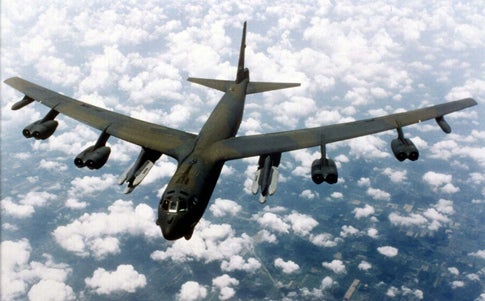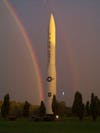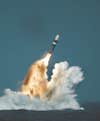The nuclear arsenals of China and the U.S.: Plans for a future armageddon
A quick run-down of they have now, and what they'll get in the coming decades.

In both Beijing and Washington D.C., nuclear weapons and their delivery systems have become particularly big news lately. In China, the DF-41 Intercontinental Ballistic Missile (ICBM) is already driving in the streets of Manchuria. Stateside, President Trump has just received a briefing at the Pentagon on America’s nuclear plans.
Here’s a quick run-down of the nuclear systems of both countries—and what they are planning to obtain in the next 25 years:

Minuteman III
Both nations have intercontinental ballistic missiles (ICBMs) buried inside fortified underground missile silos. China’s workhorse ICBM is the massive, 183-ton DF-5, which has a range of over 7,450 miles and the capacity to carry 3.2 tons—as either be a 5 megaton “city buster” hydrogen bomb, or, more recently, 3 to 8 multiple independently targetable reentry vehicle (MIRV) nuclear warheads, that can each individually strike a different target. While powerful, the DF-5 uses liquid fueled engines, requiring a lengthy fueling process before launch, making it vulnerable to a first-strike attack. The US’s LGM-30G Minuteman III ICBM, of which 440 are based in Midwestern silos, is much smaller and carries only three nuclear warheads. However, its solid-fueled engines make it far more survivable, since it can be launched in mere minutes.

DF-31A ICBM
Mobile ICBMs, carried on dedicated carrier trucks, can be launched in any open space; their mobility makes them more survivable and harder to find compared to their larger, silo-bound brethren. America does not have any known mobile ICBMs, but China has two solid-fueled variants: the DF-31A and DF-41. The three-stage DF-31A, with an estimated range of over 6,835 miles, has a payload of three to five 150 kiloton MIRV warheads, making it powerful enough to strike most of the continental USA from Chinese territory.

DF-41
The 9,320-mile-range DF-41 ICBM is one of the world’s most lethal missiles. Weighing about 80 tons, it is carried and launched by a 12X12 all-terrain truck, and can also be launched from rail. Its payload of 12 MIRV nuclear warheads can be augmented with decoys and jammers to confuse enemy sensors, letting the actual warheads slip past missile defenses. Currently, a Chinese Rocket Force brigade of 10-12 launchers is forming in northeastern China, near the Russian border. (Ironically, the DF-41 poses little threat to Russia there since its large minimum range makes it impossible to hit most Russian territory from its current position)
In the future, the USAF Strategic Command hopes the Ground Based Strategic Deterrent (GBSD) ICBM can replace the Minuteman III, which is likely to remain only silo-based. China is likely to continue with advanced derivatives of the DF-31 and DF-41 missiles; further iterations would likely have increased accuracy, more sophisticated decoys to spoof missile defense systems, and hypersonic gliders.

ALCM
America has a clear lead in nuclear-capable bombers with its stealthy B-2 and venerable B-52 bombers. While both bombers can carry nuclear gravity bombs, the AGM-86 Air Launched Cruise Missile is the primary nuclear strike weapon for the B-52. The 1,490-mile-range ALCM carries a 150 kiloton (adjustable) W80 nuclear warhead and has some stealth characteristics. Similarly, China’s only bomber, the H-6K (less than half the size of the B-52), also uses stand-off attack, in the form of the nuclear capable CJ-20 cruise missile. However, the combined combat radius of the H-6K (2,175 miles) and CJ-20 range (1,243 miles) are too short to reach continental US territory.

Air Delivery

H-20
Both nations are focusing on new stealth bomber programs. The USAF plans to receive the first B-21 Raider stealth bomber in the 2020s, while China is anticipated to fly the larger H-20 stealth bomber in the same timeframe. The B-21 is believed to be a highly networked, twin-engine aircraft, about two thirds the size of the 200-ton B-2, while the H-20 has been floated in defense circles as a four-engined, 200-ton bomber with global reach.

B-21 Raider
The B-21 will be armed with the Long Range Stand Off (LRSO) missile for long-range nuclear strike missions. It will be a stealthy cruise missile, with AI and enhanced electronic warfare capabilities to survive enemy air defenses. Meanwhile, China’s GS-6A stealth cruise missiles could be the basis for a nuclear capable version.

Trident II D5
SSBNs are the last, and most secretive, leg of the nuclear triad. Currently, the US Navy has a combination of the stealthy Ohio SSBNs and three stage, solid fueled Trident II D5 missiles. Ohio SSBNs can hide anywhere in the oceans until directed to launch their 24 Trident II missiles, the D-5 can carry up to 12, 100 kiloton W76 warheads or reach a range of over 12,000km. While latest Chinese SSBN, the Type 094A and its 12 6,213-mile range JL-2A missiles, can attack parts of the continental USA from Chinese home waters, the PLAN still has a long ways to establish a credible naval nuclear deterrent, as its submarines are not as stealthy.

Columbia Class
Capable as they are, the Ohio SSBNs are due to be replaced by the Columbia SSBN, of which the first will enter service in 2031. Compared to the Ohio, the Columbia will carry only 16 missiles, but have quieter electrical propulsion and pump-jet propulsion. For its part, China will likely field a follow on to the Type 094A, the prospective Type 096 SSBN, which is expected to be stealthier than the Type 094A. The Type 096 may also carry a newer missile to replace the JL-2.

Old and New
While the world’s nuclear powers, through the Nonproliferation Treaty, have committed to the ultimate goal of global nuclear disarmament, the reality is that they will keep and continue to build nuclear arsenals of warheads and delivery platforms for the foreseeable future. And while the nuclear arsenal of the future may resemble today’s weapons in the shape of missiles, bombers, and submarines, advance in fields like robotics, hypersonic propulsion, and missile defenses could transform the deadly science of nuclear weapons.
You may also be interested in:
China’s new microwave weapon can disable missiles and paralyze tanks
Meet China’s Sharp Sword, a stealth drone that can likely carry 2 tons of bombs
B-52 bombers to get longer-range cruise missiles
The Air Force’s newest bomber plane is named the B-21 Raider
An electromagnetic arms race has begun: China is making railguns too